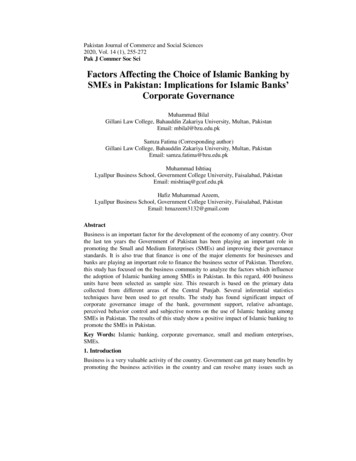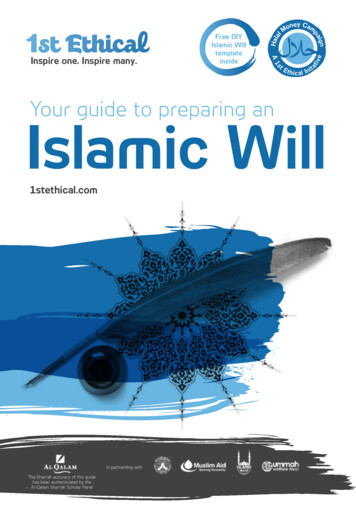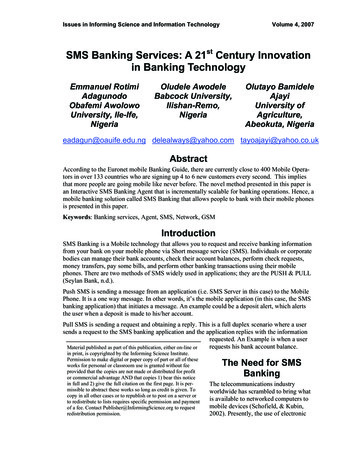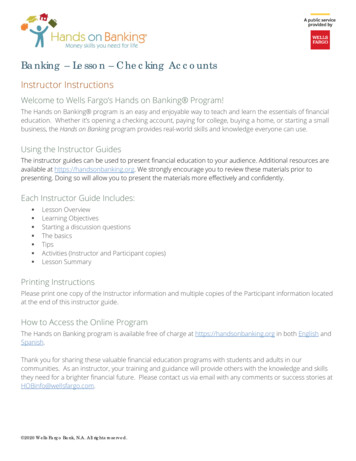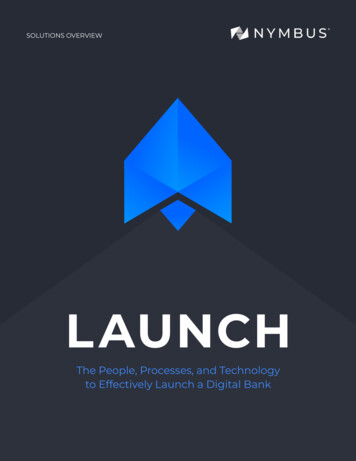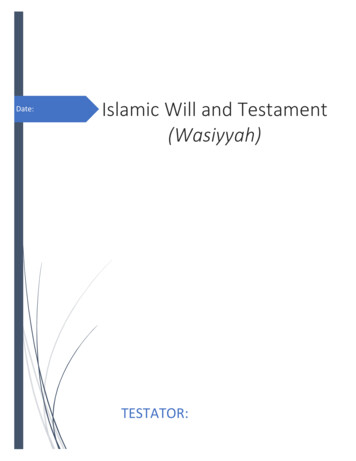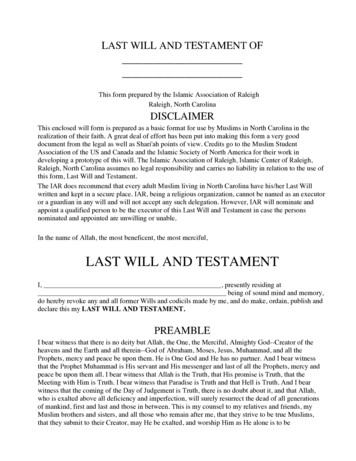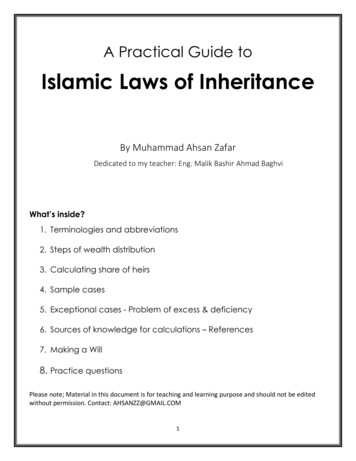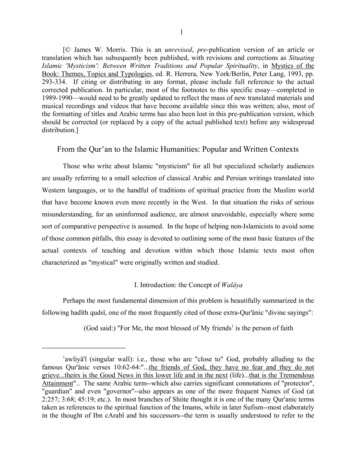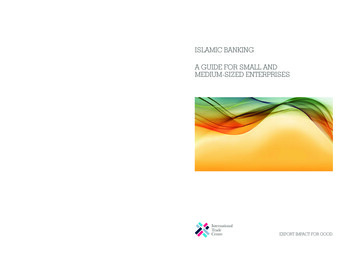
Transcription
ISLAMIC BANKINGA GUIDE FOR SMALL ANDMEDIUM-SIZED ENTERPRISESUSD 70ISBN 978-92-9137-375-8United Nations Sales No. E.09.III.T.10EXPORT IMPACT FOR GOOD
International Trade Centre 2008The International Trade Centre (ITC) is the joint agency ofthe World Trade Organization and the United Nations.Street address:ITC,54-56, rue de Montbrillant,1202 Geneva, SwitzerlandPostal address:ITC,Palais des Nations,1211 Geneva 10, SwitzerlandTelephone: 41-22 730 0111Fax: 41-22 733 intracen.orgITC publications can be purchased from ITC’s website: www.intracen.org/eshop and from:䊳United Nations Sales & Marketing SectionPalais des NationsCH-1211 Geneva 10, SwitzerlandFax: 41 22 917 00 27E-mail: unpubli@unog.ch (for orders from Africa, Europe and the Middle East)and䊳United Nations Sales & Marketing SectionRoom DC2-853, 2 United Nations PlazaNew York, N.Y. 10017, USA (for orders from America, Asia and the Far East)Fax: 1/212 963 3489E-mail: publications@un.orgOrders can be placed with your bookseller or sent directly to one of the above addresses.
ISLAMIC BANKINGA GUIDE FOR SMALL ANDMEDIUM-SIZED ENTERPRISESGeneva 2009
iiA BSTRACT FOR TRADE INFORMATION SERVICES2009F-04.01ISLINTERNATIONAL TRADE CENTRE (ITC)Islamic Banking: A Guide for Small and Medium-sized EnterprisesGeneva: ITC, 2009. x, 101 p.Guide dealing with methods to access Islamic finance, and examining the role of Islamic bankingin assisting export activities of small firms – highlights the evolution of the Islamic bankingindustry, and describes the instruments used to finance clients; outlines key principles andperspectives of Islamic banking relevant to small firms; provides an overview of the Islamicmicrofinance sector and identifies possible challenges to its growth; explains how to use Islamicbanking instruments for specific transactions; includes a case study on Islamic banking forwomen in Malaysia.Descriptors: Banking, Islamic Countries, SMEs, Microfinancing, Gender, Case Studies.EnglishITC, Palais des Nations, 1211 Geneva 10, SwitzerlandThe designations employed and the presentation of material in this publication do not imply theexpression of any opinion whatsoever on the part of the International Trade Centre concerningthe legal status of any country, territory, city or area or of its authorities, or concerning thedelimitation of its frontiers or boundaries.Mention of firm names, commercial products and brand names does not imply the endorsementof ITC.Digital image on the cover: ShutterstockIllustrations for figures and tables: Shutterstock International Trade Centre 2009All rights reserved. No part of this publication may be reproduced, stored in a retrieval system or transmittedin any form or by any means, electronic, electrostatic, magnetic tape, mechanical, photocopying or otherwise,without prior permission in writing from the International Trade Centre.ITC/P235.E/BE/09-XIISBN 978-92-9137-375-8United Nations Sales No. E.09.III.T.10
AcknowledgementsThis guide to Islamic Banking was prepared by the International TradeCentre, with the support of the REDmoney Group, a Malaysia-based companyfocusing on the global market in Islamic finance.Authors from three continents have contributed to this publication, and theinitial draft was reviewed by a sample of the expected users of the guide –trade support institutions in six countries. This was followed by intensivereviews by ITC’s trade finance and publications team, in order to developthe final outline and contents of this guide. It is ITC’s hope that the bookwill enhance understanding of a banking system that can offer an alternativefor conducting financial transactions related to exports for small firms indeveloping countries.A number of distinguished authors, bankers, professors and journalistscontributed to this guide. ITC would especially like to recognize thecontributions of AbdulKader Thomas, SHAPE Financial Corporation;Shabnam Mokhtar; Natalie Schoon, Bank of London and the Middle East;Nimrah Karim, Michael Tarazi and Xavier Reille, Consultative Group toAssist the Poor; and Jamelah Jamaluddin, RHB Islamic Bank.Several research papers have also provided useful background for thispublication. ITC wishes to acknowledge the contributions in this regard fromDavid Loundy, Devon Bank; David Testa, Gatehouse Bank; Nathif Adam,First Community Bank; Global Investment House; Badlisyah Abdul Ghani,CIMB Islamic; Mahmoud Abushamma, HSBC Amanah Indonesia; MohamadNedal Alchaar, Accounting and Auditing Organization for Islamic FinancialInstitutions (AAOIFI); and Nik Norishky Thani and Nik Norzrul Thani,Islamic Finance, Dubai International Financial Centre.Peer reviews of the initial draft of this publication were contributed by NabilShalaby, Eastern Province Chamber of Commerce and Industry, Saudi Arabia;Sabur Khan, Daffodil Group, Bangladesh; Sailendra Narain, Centre for SMEGrowth and Development Finance (CESMED), India; and Noor Yusoff, MNYConsulting. SDN Berhad of Malaysia advised the drafting team, drawing onits experience in Islamic banking applications.Special thanks go to Andrew Morgan, Geraldine Chan and Melisa MelinaIdris, from the REDmoney Group, who provided support and flexibility inorganizing research, identifying contributors and collecting contributions forthis guide.The guide was conceived and directed by Roger A. Mégélas, who managesITC’s Trade Finance for SMEs programme. Mrs Aicha Pouye, ITC Director ofthe Division of Business and Institutional Support provided the inspirationand encouragement for this guide.
ivMr Mégélas was seconded by Mauren Devolder, Adviser Trade Finance forSMEs, and assisted by Uyanga Dorjgotov, programme assistant and SiriratKiatichaipaibul, intern.Editorial management and promotion was conducted by Natalie Domeisen.Julie Wolf served as Senior Editorial Consultant, providing advice andextensive editing. Leni Sutcliffe also contributed editing services. NatalieDomeisen, Leni Sutcliffe and Michel Favre prepared the book for printing.
ContentsAcknowledgementsiiiIntroduction1Part One: Understanding Islamic finance3Chapter 1Basic principles of Islamic bankingEvolution of Islamic bankingFoundation of Islamic bankingSale-based instrumentsMurabahahSalamIstisnaLease-based instrumentsPartnership-based instrumentsMusharakahMudarabahConcluding observations556668889999Chapter 2Islamic banking for SMEsPartnership contractsJoint ventureDiminishing MusharakahPassive partnershipInstruments with predictable returnsDeferred payment saleLeasingShort-term production financeLong-term production financeOther instrumentsForeign exchangeLetters of creditGuaranteeUnilateral promiseDown payment11111112121414151617181819191919
viAgency agreementInvestment certificateWhich transaction type?When Islamic finance may or may not be the best choiceProhibited industriesTransaction-type considerationsOther general considerationsCostPurposeInformationLegal and tax requirements2020222323242424242525Chapter 3Islamic microfinance: an emerging market niche26Development of the Islamic finance industryGlobal expansionGovernment regulationInternational organizationsIslamic microfinanceDemandGovernment promotion of Islamic microfinanceIndonesiaPakistanBanks downscaling and expanding product lineIslamic microfinance: CGAP survey resultsLimited outreachIslamic microfinance by institution typeFocus on IndonesiaPossible challenges to the growth of Islamic microfinanceThe question of authenticityBuilding capacityProduct diversityLeveraging Zakat and Islamic funds28282833292930303031313133343435353636Chapter 4Islamic banking for women: a case studyOccupational structureInvestment habits of womenNeed for Islamic banking for womenWomen’s economic roleMultitaskingFinancial planningWomen as entrepreneursAz Zahra privilege ladies bankingConcept and strategyCustomer profileProducts and services offeredAz Zahra Equity Home Financing-iAz Zahra Mudarabah Current Account-iAz Zahra Mudarabah General Investment Account-iAz Zahra Hire Purchase-i37373940404040404141424242424343
viiBanking for women in other countriesMasrafy Bank, BahrainEmirates Islamic Bank, United Arab EmiratesFurther opportunities43434444Part Two: Using Islamic Finance45Introduction47Chapter 5Islamic finance: what it is and where it is available to SMEs48Introduction48Basic distinctions between Islamic and conventional bankingDepositsLending contrasted to credit and investmentConcluding observations50515354Chapter 6Key products and how they compareto conventional counterpartsMurabahah (cost-plus sale)Key distinctionsSimple MurabahahStrengths and weaknesses for micro-enterprises and SMEsAlternative applications of simple MurabahahAgency MurabahahStrengths and weaknesses for micro-enterprises and SMEsAlternative application of agency MurabahahMurabahah to purchase orderStrengths and weaknesses for micro-enterprises and SMEsAlternative application of Murabahah to purchase orderMusawamahStrengths and weaknesses for micro-enterprises and SMEsAlternative applications of Murabahah for working capitalBai al InahTawarruqStrengths and weaknesses for micro-enterprises and SMEsConcluding observationsIjarah – leasingStrengths and weaknesses for micro-enterprises and SMEsIjarah Muntahiyah Bi Tamleek – lease ending in ownershipStrengths and weaknesses for micro-enterprises and SMEsSale leasebackForward Ijarah – forward leaseAlternative application of forward IjarahStrengths and weaknesses for micro-enterprises and SMEsConcluding 646465666667676768
viiiBai al Salam – forward saleSimple SalamStrengths and weaknesses for micro-enterprises and SMEsParallel SalamStrengths and weaknesses for micro-enterprises and SMEsSalam against undertakingStrengths and weaknesses for micro-enterprises and SMEsConcluding observationsBai al Istisna (construction/manufacturing)Simple IstisnaStrengths and weaknesses for micro-enterprises and SMEsParallel IstisnaStrengths and weaknesses for the micro-enterprise and SMEConcluding observationsMusharakah (joint venture/partnership)Simple MusharakahStrengths and weaknesses for micro-enterprises and SMEsDeclining balance MusharakahStrengths and weaknesses for micro-enterprises and SMEsAlternative application of declining balance MusharakahImport finance MusharakahStrengths and weaknesses for micro-enterprises and SMEsConcluding observationsMudarabah (managed partnership)Strengths and weaknesses for micro-enterprises and SMEsMudarabah depositWakalahConcluding 777778797980808182Chapter 7Providers of Islamic financingFully fledged Islamic banksIslamic windowsLimited Islamic product OfferingsThe Islamic Development Bank GroupConcluding observations838383848485Chapter 8Accessing Islamic finance86Considering Islamic financeChoosing Islamic financeStep 1 Pre-applicationStep 1.1 Pre-application: understanding the company’s financial needsStep 1.2 Pre-application: determining the right financial instrumentStep 1.3 Pre-application: Finding the right financier and service providerStep 2 ApplicationStep 2 Application: Documentation and fundingStep 3: Approval and post-closing868788888989898990Annex: Application and closing checklist for the micro-enterprise and SME92
ixChapter 9The role of a sharia adviser95Chapter 10Regulations, tax implications and jurisdictional guidelinesRegulatorsTax implicationsJurisdictional issuesConclusionAppendix: Frequently asked questions9797989899101Tables1. Financing instruments in Islamic banks2. Outreach of Islamic microfinance, by country3. Outreach of Islamic microfinance, by institution type4. Malaysia, women at decision-making level in the public sector, 20075. Malaysia, women at decision-making level in the corporate sector, 20071032333939Figures1. A simple Musharakah transaction2. A simple Mudarabah structure3. A simple Murabahah structure4. Operating lease5. A financial lease6. A simple Salam structure7. A simple Istisna structure8. A simple Bai al Arboon structure9. A simple Sukuk structure10. Malaysia: population by stratum and sex, 200711. Malaysia: distribution of male employment by occupation, 200612. Malaysia, distribution of female employment by occupation, 200613. Malaysia, public-sector personnel by service group and sex, 200614. Depositor-bank relationship in a conventional bank15. Mudarabah PSIA relationship in an Islamic bank16. Simple Murabahah17. Agency Murabahah18. Murabahah to purchase order19. Musawamah20. Bai al Inah21. Tawarruq22. Ijarah23. Ijarah Muntahiyah Bi Tamleek – lease ending in ownership24. Leaseback25. Forward Ijarah26. Simple 5666769
x27.28.29.30.31.32.33.34.35.36.Parallel SalamSalam against undertakingSimple IstisnaParallel IstisnaMusharakahDeclining balance MusharakahImport finance MusharakahMudarabah financingMudarabah depositPre-application stepsBoxes1. Basic Islamic microfinance contracts2. How do savings work?3. A look at the Islamic Republic of Iran70717273767778808188262832
IntroductionThe 2008 financial crisis and subsequent drying up of credit had a particularlysevere impact on small and medium-sized enterprises, especially in developingeconomies.Vastly diminished export opportunities and a weakened banking systemadded to the difficulties that small and medium-sized companies traditionallyface in accessing finance. Banks have been even more reluctant to take onrisk linked to small enterprises. Such companies have also been shaken by theuncertainties unleashed by the crisis, including questions about the soundnessof existing financial institutions.Even as confidence returns and credit begins to flow again, the crisis underlinedthe need for small firms to know as much as possible about their financingoptions. Among the alternatives are systems such as microfinance and Islamicbanking, which are growing in size and reach.Islamic banking is not recent. Emerging as early as
Islamic Banking: A Guide for Small and Medium-sized Enterprises Geneva: ITC, 2009. x, 101 p. Guide dealing with methods to access Islamic finance, and examining the role of Islamic banking in assisting export activities of small firms – highlights the evolution of the Islamic banking industry, and describes the instruments used to finance clients; outlines key principles and perspectives of .
